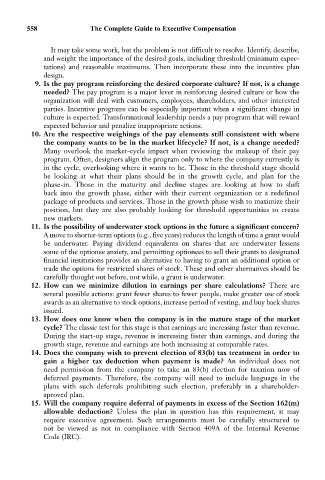Page 572 - Bruce Ellig - The Complete Guide to Executive Compensation (2007)
P. 572
558 The Complete Guide to Executive Compensation
It may take some work, but the problem is not difficult to resolve. Identify, describe,
and weight the importance of the desired goals, including threshold (minimum expec-
tations) and reasonable maximums. Then incorporate these into the incentive plan
design.
9. Is the pay program reinforcing the desired corporate culture? If not, is a change
needed? The pay program is a major lever in reinforcing desired culture or how the
organization will deal with customers, employees, shareholders, and other interested
parties. Incentive programs can be especially important when a significant change in
culture is expected. Transformational leadership needs a pay program that will reward
expected behavior and penalize inappropriate actions.
10. Are the respective weighings of the pay elements still consistent with where
the company wants to be in the market lifecycle? If not, is a change needed?
Many overlook the market-cycle impact when reviewing the makeup of their pay
program. Often, designers align the program only to where the company currently is
in the cycle, overlooking where it wants to be. Those in the threshold stage should
be looking at what their plans should be in the growth cycle, and plan for the
phase-in. Those in the maturity and decline stages are looking at how to shift
back into the growth phase, either with their current organization or a redefined
package of products and services. Those in the growth phase wish to maximize their
position, but they are also probably looking for threshold opportunities to create
new markets.
11. Is the possibility of underwater stock options in the future a significant concern?
A move to shorter-term options (e.g., five years) reduces the length of time a grant would
be underwater. Paying dividend equivalents on shares that are underwater lessens
some of the optionee anxiety, and permitting optionees to sell their grants to designated
financial institutions provides an alternative to having to grant an additional option or
trade the options for restricted shares of stock. These and other alternatives should be
carefully thought out before, not while, a grant is underwater.
12. How can we minimize dilution in earnings per share calculations? There are
several possible actions: grant fewer shares to fewer people, make greater use of stock
awards as an alternative to stock options, increase period of vesting, and buy back shares
issued.
13. How does one know when the company is in the mature stage of the market
cycle? The classic test for this stage is that earnings are increasing faster than revenue.
During the start-up stage, revenue is increasing faster than earnings, and during the
growth stage, revenue and earnings are both increasing at comparable rates.
14. Does the company wish to prevent election of 83(b) tax treatment in order to
gain a higher tax deduction when payment is made? An individual does not
need permission from the company to take an 83(b) election for taxation now of
deferred payments. Therefore, the company will need to include language in the
plans with such deferrals prohibiting such election, preferably in a shareholder-
aproved plan.
15. Will the company require deferral of payments in excess of the Section 162(m)
allowable deduction? Unless the plan in question has this requirement, it may
require executive agreement. Such arrangements must be carefully structured to
not be viewed as not in compliance with Section 409A of the Internal Revenue
Code (IRC).

